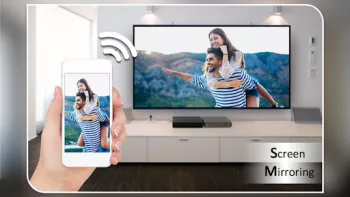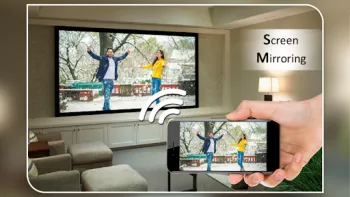Apps Home

The Evolution and Technological Advancements in Screen Mirroring
Screen mirroring technology has evolved tremendously over the past decades, making "Seamless Screen Control" an accessible reality for many users globally. Screen mirroring allows a secondary screen, typically larger, to display content from a primary device, such as a smartphone or tablet, in real-time. This technological leap was driven largely by the increased demand for content sharing and multi-device interoperability, which saw initial stages in the realms of industrial and corporate settings before gaining momentum in consumer markets. Early devices relied heavily on HDMI cables and other tethered solutions to achieve this functionality, but as wireless technology expanded, so too did the potential for screen mirroring to become wireless. With modern developments, protocols like Miracast, Google Cast, Apple AirPlay, and DLNA have emerged, allowing users to comfortably navigate and utilize screen mirroring capabilities without physical connectors. These protocols facilitate the instant transfer of video and audio signals by compressing data packets sending them over a Wi-Fi network, thus enabling the remote viewing of one's device screen onto TV displays and projectors. Each protocol leverages specific encoding techniques and Wi-Fi direct connections, which assure minimal latency and quality loss—a true representation of technological synergy. The technological advancements in devices, network speeds, and encoding processes have all combined to create a platform where "Effortlessly Mirror Your Screen" is indeed achievable, functioning seamlessly across diverse operating environments.
Applications and Practical Uses of Screen Mirroring in Daily Life
Screen mirroring has myriad applications across various use cases in daily life, extending beyond simple entertainment into the professional realm and educational sectors. One of the most ubiquitous uses is in entertainment—being able to cast movies, video games, or music videos from personal devices directly to a home television significantly enhances the viewing experience by offering users a larger screen and, often, superior audio output systems. For families, this feature enriches social gatherings, providing a handy tool for everyone to share multimedia content interactively. In the professional world, screen mirroring has redefined workplace presentations by streamlining the sharing of slides, charts, and analytics sheets without needing cumbersome data transfers or device compatibility checks, encouraging efficiency and productivity. The same advantages are applied in educational settings, where teachers can share content from their devices with entire classrooms, providing real-time interaction with educational materials, enhancing learning. Furthermore, screen mirroring technology supports remote collaboration, where digital teams can readily share their screens during virtual meetings, facilitating seamless discussion and explanation. Beyond just screen sharing, this technology has also integrated tools for annotation and interaction, making it possible for viewers to engage interactively with shared materials, thereby broadening the scope of its application significantly. Ultimately, screen mirroring continues to transcend the bounds of traditional content sharing, adapting swiftly to the evolving demands of modern users and settings.
Technological Components that Facilitate Seamless Screen Mirroring
The effectiveness of screen mirroring is largely attributed to the underlying technological components that work cohesively to provide a seamless experience. Integral to this process is the role of Wi-Fi networks and display protocols such as HDCP (High-bandwidth Digital Content Protection), which ensure that data is transferred securely and efficiently across devices. Establishing a stable connection between an Android device and a TV or any receiving device requires both sender and receiver to be on the same network, thus emphasizing the crucial role of a reliable Wi-Fi network. Devices employing screen mirroring must efficiently compress and decompress audio and video signals to minimize latency, a task handled adeptly by video codecs like H.264 and more advanced algorithms like HEVC (High Efficiency Video Coding). These codecs are designed to retain high picture quality while using limited bandwidth, optimizing the mirroring experience. Additionally, the presence of auxiliary technologies like Bluetooth for initial device discovery and connection setup enhances the quick pairing of devices in the initial configuration stages. Furthermore, many modern devices are equipped with dedicated hardware encoders and decoders that eliminate the computational load from the device processor, making screen mirroring a less battery-intensive activity, more sustainable for prolonged usage. The interoperability of various operating systems and devices presents another development facet, where increased compatibilities between Android, iOS, Windows, and TV operating systems smoothens integration, fostering an environment for effective cross-platform functionality.
Overcoming Challenges in Screen Mirroring
Despite the many advances in "Seamless Screen Control," there are distinct challenges that developers and users have encountered in achieving truly seamless experiences. One notable issue is network congestion and the common variability in Wi-Fi speeds, which may result in laggy or choppy video reception during screen casting. It's critical for users to ensure their network infrastructure is robust, utilizing dual-band routers and ensuring limited interference from other wireless signals in densely populated areas. Additionally, achieving perfect synchronization of audio and video streams merits attention, as latency differences can sometimes lead to delayed audio output—this requires nuanced synchronization adjustments within the app's settings or better audio-visual codec pairings. Compatibility remains another perennial hurdle, especially with the diverse landscape of television operating systems and devices that may not natively support certain screen mirror protocols or lack necessary hardware capabilities, necessitating workarounds via dongles or adapters. Moreover, security is a growing concern with screen sharing technology as device communications open potential vectors for unauthorized access; users must be cautious and ensure secured networks by updating firmware and using encrypted connections. Lastly, battery usage in mobile devices during extended mirroring sessions is concerning; developers are addressing this by integrating energy-efficient encoding techniques and allowing users to disable unnecessary background functions during a screen casting session.
Exploring Future Trends in Screen Mirroring Technology
The future of screen mirroring technology promises exciting enhancements and possibilities driven by ongoing innovation in communication protocols and device interoperability. The advent of 5G technology presents potential transformations, offering significantly increased data transfer rates and more flexible, expansive connectivity options, thereby likely addressing prevalent issues such as latency and connectivity range. Additionally, artificial intelligence and machine learning may interject more intuitive solutions into screen mirroring experiences, bringing advanced features like automatic network adjustment based on user patterns, predictive loading optimizations, and context-aware recommendations for optimal device combinations. Another growing trend is the development of augmented reality and virtual reality applications that leverage screen mirroring for immersive presentations and remote interactions, pushing the boundaries beyond 2D projections to more interactive, 3D displays. On the software front, applications are expected to incorporate more diverse integrations with productivity tools, collaborating platforms, and other digital ecosystems, creating more holistic solutions that align with consumer and professional needs alike. Enhanced security measures integrated with blockchain technology offer stronger protection against privacy breaches, ensuring safe and encrypted data transmission. Looking further ahead, we can visualize a symbiotic environment where devices and high-definition screens become ubiquitous, automatically configuring and projecting content based on user preferences and real-time situational analysis, truly embodying the vision of a fully integrated digital lifestyle. Download for Android
Share Your Opinion
Your Email Will Not Be Published.
All Rights Reserved © Apps Home 2025












































A Google user
So far this app has worked just like it says it should. I tried a different app and I like this one better because it stays connected until I say s...
A Google user
Excellent app that's easy to set up & use, & does what it's supposed to. Works to play whatever video app or internet videos you want to. I'm not t...
Stan Bangtan
The best one! There are a lots of app for connecting to tv but trust me, this is the best one! You'll need 1 to 2 minute s for connecting and this ...
Marie
Works every time on my Sony bravia. So much faster than going through all the TV settings.
A Google user
decided to install several different screen mirroring apps onto my Galaxy 9+ so i could compare the good & the bad of each app which clearly would ...